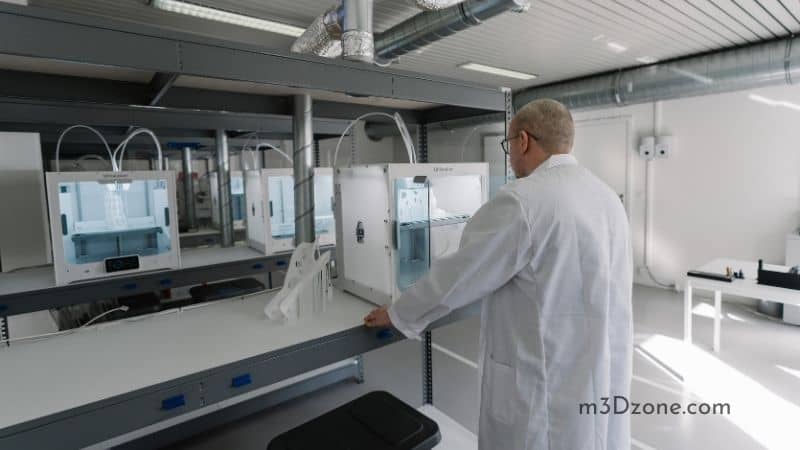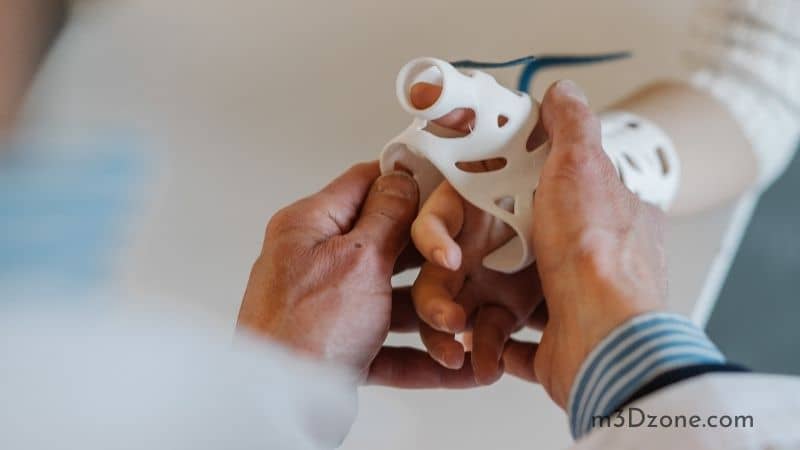
A resin 3D printer is a machine that uses light to convert models to prints. By directing UV light onto resins, these 3D printers can swiftly cure them while still maintaining high intricacy and a smooth surface finish.
In some cases, parts are ready for use as soon as printing is over. Our comprehensive guide to resin printers exposes you to all you need to know.
Quick Navigation
- What Is Resin 3D Printing? What Is a Resin 3D Printer?
- How to Use a Resin 3D Printer?
- How Does a Resin 3D Printer Work?
- How Much Resin Do I Need for 3D Printing?
- What to Do With Leftover Resin 3D Printing?
- How Strong Is Resin 3D Printing?
- How Toxic Is Resin 3D Printing?
- What Are Resin 3D Printers Good For?
- Is Resin Stronger Than PLA?
- Final Thoughts
What Is Resin 3D Printing? What Is a Resin 3D Printer?
Stereolithography (SLA)/ resin printing is a technology for creating prototypes, models, patterns, and production components in a layer-over-layer method.
It uses photochemical processes where the light leads to the cross-linking of oligomers and monomers to create polymers, forming a 3D solid.
SLA can create medical models, computer hardware, among other applications.
Resin 3D printers use the same light source (projector or laser) mechanism to convert liquid resin into hard plastic. The major physical dissimilarity lies in the arrangement of core components, like the build platform, light source, and resin tank.
These machines operate with resins which are light-reactive thermoset substances. Upon the exposure of SLA resins to particular light wavelengths, small molecular chains come together, joining oligomers and monomers to create solidified flexible or rigid geometries.
SLA parts feature the highest accuracy and resolution, the finest details, and the sleekest finishes amongst all 3D printing procedures. Regardless, the main benefits of the SLA lie in its flexibility.
Material manufacturers have come up with innovative SLA resins with numerous optical, thermal, and mechanical properties able to compete with standard, industrial, and engineering thermoplastics.
While this method can handle a large printing size and make almost every design, it may not be so budget-friendly.
How to Use a Resin 3D Printer?
Using your SLA 3D printer involves three simple steps.
1. Design
Use any 3D scan data or CAD software to come up with a model. Export your model in a printable file format, for instance, OBJ and STL. All SLA 3D printers have software to slice digital models to various layers and adjust settings.
Upon completing setup, the preparation software delivers instructions to your resin printer through a cable or a wireless connection.
2. Printing
Once you confirm your setups are okay, the SLA process starts, and your machine can function unattended till it completes your print. Resin printers with cartridge systems have automatic material refilling.
3. Post-Processing
Upon completing the process, parts need rinsing in IPA (isopropyl alcohol) to rid the surfaces of uncured resin. Once rinsed parts are dry, some materials still require post-curing to enable them to attain their highest possible sturdiness and stability.
Lastly, detach support structures from your parts, then sand the support marks for smooth finishes. SLA parts are straightforward to prime, paint, and assemble for different finishes and applications.
How Does a Resin 3D Printer Work?

3D printers for resin-based processes use neither filament nor powder but liquid resin.
-
SLA
SLA occurs in a massive tank and starts with a liquid polymer layer spread across a platform. A UV laser beam solidifies the portion that will form part of the layers of your 3D print since the polymer layer is UV-sensitive. The remaining amount stays liquid. The platform then gets lowered, followed by drawing the next layer of resin directly above the previous one.
Upon completing the print, it gets raised out of the tank through the supporting platform with the extra liquid flowing away.
Since a liquid substance gets used rather than powder, we should add support material underneath overhanging parts and those sticking out. You can then remove the supports manually after taking the model from your machine.
The resin printing process materials include mammoth resin, standard resin, gray resin, and transparent resin.
-
PolyJet Tech
Here is another technology based on resin. The PolyJet technology functions by pilling resin in extra-thin layers on a build tray until it completes the model. Each layer gets cured using UV light just after jetting. For this reason, it produces wholly cured models ready for use immediately after completion.
How Much Resin Do I Need for 3D Printing?
You should have adequate printing resin in your vat to be able to flow and fill the areas where your print is making. Go for excess amounts in your resin tank to be safe. Try keeping your vat about 1/3 filled, but don’t fill too much as it might overflow.
Build plates lower right into your vats, then drip off to your FEP films where the prints are getting cured. So, when adding more resin, simply pour it over your build plate.
Sometimes you may end up on the final portion of resin but still want to finish your 3D print. Since resin flows back to the position of your print, the best way to succeed is to ensure an even pool of resin within your vat.
If you start seeing spaces and gaps in the resin, you’ll note that it doesn’t reach your 3D models. The resin will, therefore, not cure properly underneath your 3D model leading to a failed print.
What to Do With Leftover Resin 3D Printing?
You can leave leftover resin in your tank, but ensure to properly protect it from UV light. If you’ll make a new print in a few days, you can leave your resin in your 3D printer. Otherwise, filter the uncured resin and put it back in the container.
You can remove bits of semi-cured resin, place them on a paper towel, and cure them using UV light. Ensure you don’t touch the resin as always, though after fully curing, you can safely discard them in the usual manner.
If the leftover resin mixes with the liquid cleaner, for instance, IPA, place it in a container and take it to the local recycling plant. Most places accept a leftover mix of isopropyl alcohol and resin. Nevertheless, you may sometimes have to go to a special recycling plant.
How Strong Is Resin 3D Printing?
Many people believe SLA 3D printed parts are fragile and best suited for prototyping and decorative applications rather than load-bearing and functional components. But this is only so if you don’t properly select your resins. Regardless, if you buy generic resins to use on a tough job, you won’t get the strength you are after.
Many resins with high sturdiness are available in various industries. Castable resins, for instance, make jewelry and for 3D printing dentistry products like crowns, mouth guards, and surgical guides. There’re also high-temperature resins used in different industrial applications, and resins able to make rubber-like parts.
Parts printed with tough resins have a 55.7 MPa tensile strength and 2.7 GPa modulus of elasticity which closely resembles ABS.
How Toxic Is Resin 3D Printing?
The resin’s toxicity is yet determined, but its resin is chemically toxic to people and their surroundings.
Long-term resin use can cause sensitivities. Resin isn’t something to pour down your sink or drain because of the resultant contamination.
Proper disposal of 3D printer resin is crucial, and you should cure it before disposal. Make sure you don’t inhale resin fumes as well. Have adequate ventilation, filters, and masks when dealing with such fumes.
What Are Resin 3D Printers Good For?
SLA is synonymous with swiftness, enhanced resolution, and sturdy prints.
High Resolution
While the resolution in fused deposition modeling (FDM) depends on the size of the nozzles extruding the filaments, SLA printing is limited by the size of the laser emitted to uncured resins.
This allows SLA to have better print quality with ultra-fine details and smooth surfaces only achieved in FDM after post-processing tasks.
Faster Printing
In some 3D printing methods, for example, in an FDM printer, the extruder has to move around your print bed depending on the specified patterns. The production process in FDM printers is slow, given the extruders’ weight and the precision required.
In SLA, the laser rapidly points the liquid resin in predefined patterns. DLP offers an even faster 3D printing process than FDM printers, given it cures an entire layer in one step.
Sturdy Products
Curing permits stronger layer-to-layer compaction in SLA 3D printing. Finished projects, therefore, contain more uniform mechanical properties across all axes.
Is Resin Stronger Than PLA?
Particular resin prints are sturdy, but most filament prints, including PLA, are much stronger because of their physical properties. While many resins are more brittle, filaments are more robust.
Final Thoughts
With time-saving, sturdiness, precision, there is a lot to gain from SLA. This 3D printing technology helps in various sectors like manufacturing, jewelry, dentistry, audiology, engineering, education, and more. However, always remember to take care when handling resins.
Recommended Reading
3D Print Layers Not Sticking
Why are my 3D print layers not sticking together? Layer separation is a major issue that arises when 3D printing. Let's see the fixes for this issue.
Should You Invest In a 3D Printer?
Should you invest in a 3D printer? Yes! You should invest in a 3D printer because it's a good investment. Using your creativity you can print all...
Can You 3D Print on Glass?
Can you 3D print on glass directly? Yes! You can comfortably 3D print objects on glass. It's one of the most widely used 3D printer bed among professionals.
